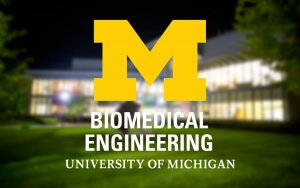Presented By: Biomedical Engineering
Ph.D. Defense: Hina Aftab Khan
Characterization and Development of a 3D Interpenetrating Hydrogel for Ovarian Cancer Mechanotransduction

Ovarian cancer is the most lethal gynecologic malignancy among women in the US, responsible for 14,000 deaths per year, and five-year survival rate of 25%. Within the primary and metastatic microenvironments in the ovary, peritoneal ascites and omentum, the ovarian cancer cells are subject to several mechanical stresses, including compressive stresses generated by uncontrolled cell growth in a confining space, increased tissue stiffness due to tumor cell extracellular matrix (ECM) remodeling, and increased interstitial fluid pressure due to the angiogenic growth of new leaky blood vessels. However, current models to study these stimuli within the ovarian tumor microenvironment are lacking in biophysical cues, relevant extracellular matrix dynamics and the ability to consistently sustain cells through the detachment process. The absence of consistent optimization of matrix composition and degradation mechanics also leads to occurrences of increased cytolysis during in vitro experimentation. In order to meet this critical unmet need, my Master’s thesis is focused on developing extracellular matrices that feature comparable consistent compositional, structural and mechanical cues. Additionally, these matrices facilitate biophysical modulation to be applicable over a wider range in a manner that allows for improved experimental precision. Given the range of matrix stiffness, permeability and porosity, I have developed and characterized hydrogels for designing extracellular mimics for ovarian cancer mechanotransduction studies.
In this work, I highlight the need for optimization of interpenetrating network (IPN) hydrogels’ homogeneity, thereby providing uniform adhesion during mechano-transduction experiments. Further, I optimized cell harvesting via thorough cell detachment without causing cytolysis for downstream analysis including, flow cytometry on detached cells. Moreover, I have characterized the rheologic, transport and structural properties of IPN hydrogels, and demonstrate how these can account for variation in experimental results. Overall, my thesis provides insight into the significance of hydrogel matrix composition when constructing cell scaffolds for specific cellular microenvironments.
Owing to their success as natural hydrogel scaffolds, I utilized alginate and agarose to design the ovarian cancer extracellular matrices. Within these networks, collagen served as the second component of the IPN network, providing an anchoring fibrillar network for the cells within the otherwise non-fibrillar material, and further enhancing the biocompatibility of the scaffold. I varied the IPN hydrogel composition to demonstrate a relevant range structural and mechanical properties. Further, I characterized the homogeneity, morphology, fiber structure, stiffness, gelation time, permeability and porosity of IPN hydrogels. Lastly, I evaluated ovarian cancer cells for cellular function post-harvest from IPN hydrogels, to demonstrate successful detachment and degradation of the surrounding matrix.
The results of this study enable tailoring of the IPN hydrogel extracellular matrices according to required mechanical, structural, and biophysical parameters for not only ovarian cancer, but also other originating tissues for improved robustness and reliability of the in vitro cancer bioengineering models.
Chair: Dr. Geeta Mehta
In this work, I highlight the need for optimization of interpenetrating network (IPN) hydrogels’ homogeneity, thereby providing uniform adhesion during mechano-transduction experiments. Further, I optimized cell harvesting via thorough cell detachment without causing cytolysis for downstream analysis including, flow cytometry on detached cells. Moreover, I have characterized the rheologic, transport and structural properties of IPN hydrogels, and demonstrate how these can account for variation in experimental results. Overall, my thesis provides insight into the significance of hydrogel matrix composition when constructing cell scaffolds for specific cellular microenvironments.
Owing to their success as natural hydrogel scaffolds, I utilized alginate and agarose to design the ovarian cancer extracellular matrices. Within these networks, collagen served as the second component of the IPN network, providing an anchoring fibrillar network for the cells within the otherwise non-fibrillar material, and further enhancing the biocompatibility of the scaffold. I varied the IPN hydrogel composition to demonstrate a relevant range structural and mechanical properties. Further, I characterized the homogeneity, morphology, fiber structure, stiffness, gelation time, permeability and porosity of IPN hydrogels. Lastly, I evaluated ovarian cancer cells for cellular function post-harvest from IPN hydrogels, to demonstrate successful detachment and degradation of the surrounding matrix.
The results of this study enable tailoring of the IPN hydrogel extracellular matrices according to required mechanical, structural, and biophysical parameters for not only ovarian cancer, but also other originating tissues for improved robustness and reliability of the in vitro cancer bioengineering models.
Chair: Dr. Geeta Mehta
Explore Similar Events
-
Loading Similar Events...
